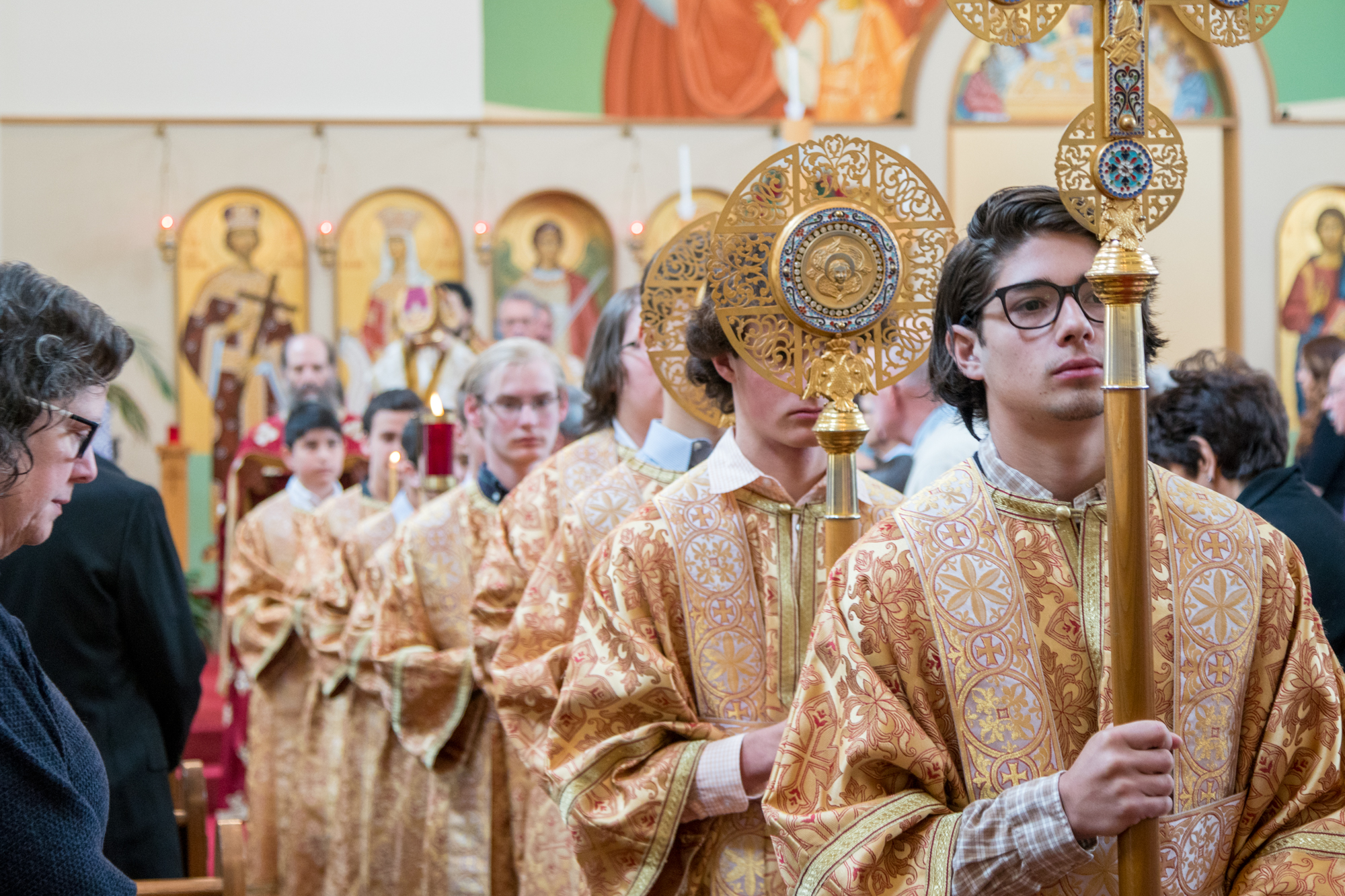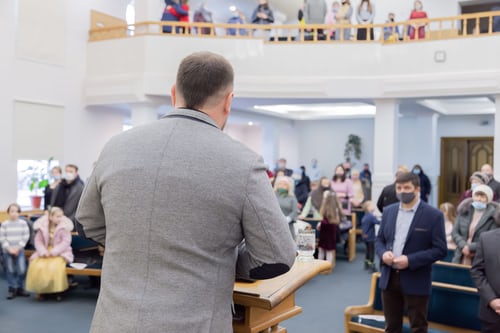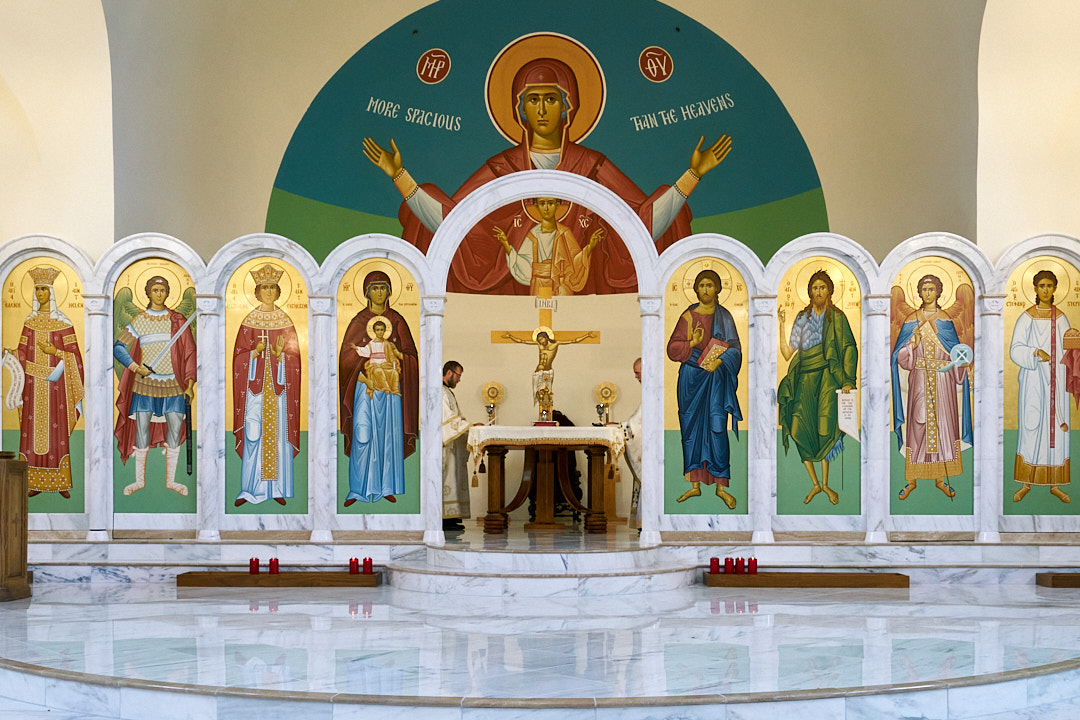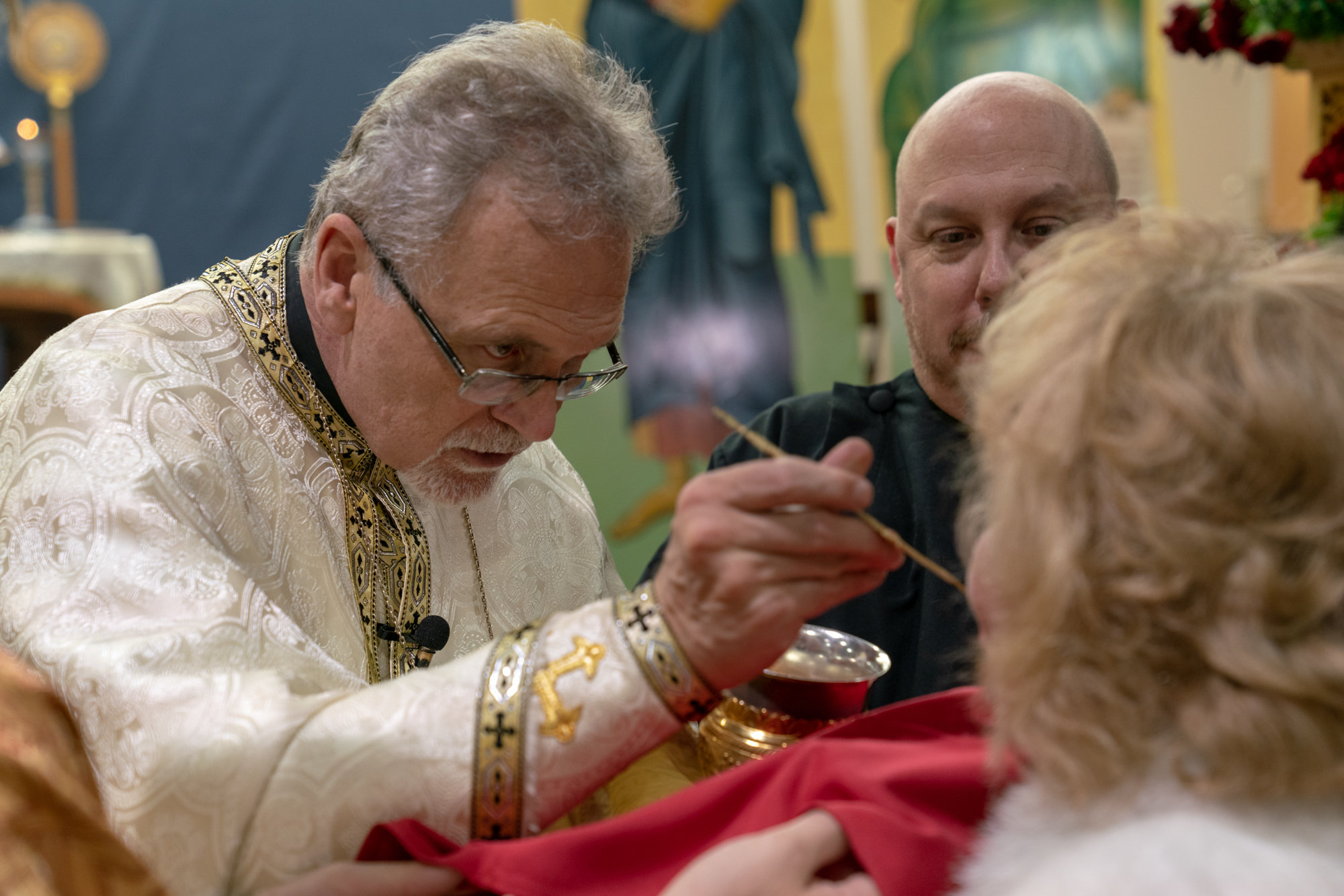Sometimes the major obstacle to becoming Orthodox isn’t theological at all—it’s the worship service itself.

My husband Rob and I both grew up in a United Methodist Church with stained glass, pews, hymns, a pipe organ, and a choir singing anthems. We had to go forward to receive communion at an altar rail at the front of the church, and the pastors wore academic-style gowns. So we were familiar with a more formal style of worship. But but that was many years ago.
The formality disappeared during our adult years—our experiences mirrored the changes in the Evangelical world. Stained glass and pews gave way to folding chairs in auditorium-style sanctuaries; worship bands using rock-music instruments replaced choirs, organs, and hymnals. The lyrics to songs and hymns were projected onto large screens above a stage, and communion was usually served by passing a dish of crackers down the row of seats, followed by a tray of grape juice in little plastic cups.

We have many wonderful memories from these churches—in Oklahoma, Texas, California, and Colorado. They were filled with loving, committed Christians, and although the services were way more casual than an Orthodox Liturgy, they were not chaotic; each church practiced its own form of liturgy, in the small-L sense. An order of service always existed, and typically, it went something like this:
Donuts and coffee in the fellowship area
Assembly of the congregation in the sanctuary
Welcome message
Music: usually two fast songs and one slow one (Don’t even get me started on the lyrical content.)
Prayer
Scripture reading
Sermon
Passing of the offering plate or basket
Another Song
Closing Prayer
Announcements
Once a month—or every two months, or sometimes even quarterly—communion was added to the schedule after the sermon, along with a prayer and Jesus’ words of institution beforehand.
In the churches we attended, the content of the sermons was Christ-centered and focused on the Scriptures, because we made a point of attending churches with these values. The dress code was casual but modest, and the walls were mostly bare except for a cross onstage or to the side. However, in the past few decades many churches have been removing even the cross so that the only visual cues that we are assembled in a distinctly Christian space are the words and images projected on the screen. During the rest of the week, the place could pass for a hotel conference room.
The First Orthodox Parish Visit: Beautiful and Disorienting
If you’re from this kind of church background, your first visit to an Orthodox parish can be jarring. Even if you’ve been reading the early Church Fathers or a book about Orthodoxy, you may feel like you’ve entered a different world.
Actually, you have. But we’ll get to that in a moment.
For me, the ritual and the sensory feast of the Divine Liturgy somehow drew me in. I remember specifically being struck by a sense of honor—honor for God and for the brothers and sisters in Christ who came before us. Honor is something that has been mostly lost in American society, except perhaps in the military, and the holiness of the Liturgy satisfied a hunger in me that I couldn’t articulate. I kept coming back, even though I didn’t understand everything that was going on.
But for others, like my husband, the Divine Liturgy is not so much a sensory feast as sensory overload. Initially for him, the formality was wildly off-putting. He loved the unchanging beauty and consistency of Orthodox theology but was uncomfortable with the length of the Liturgy, the unsmiling saints in the icons—he thought they looked sad—the scripted service, and the unfamiliar music.

A lot of newcomers feel this way. So do Orthodox people who have returned to the Church after a long absence. These folks have a practical question:
Why is Orthodox worship so formal?
It’s a fair question, especially if you’re used to choosing from a smorgasbord of churches. In America, we’re all about choice. Protestants especially look for a “good fit” for ourselves and our families in terms of doctrine, worship style, and activities.
But in order to answer the question about Orthodox formality, it’s important to answer the simple, foundational question underneath it, which is:
Why do we gather together for worship in the first place?
Why are we here? What’s the point of getting up early on a Sunday instead of sleeping in or playing golf? The answer to that question determines what goes on in any worship service at any church. For example, if the answer is, “We gather for worship to experience God’s presence together”—which is a very good answer, by the way—then the worship service will be organized so as to maximize our experience of God’s presence. This, of course, begs the question, “How can we best experience God’s presence?”
Then the answer to that question will determine things like musical style, the words that we proclaim in song, whether we speak in tongues, how closely we follow tradition, or if we will pass the microphone to someone with a gift of prophecy who has a “word from the Lord.”
Our understanding of worship determines what we do when we gather together.
As I kept attending, I slowly discovered that the Orthodox understanding of what’s going on any given Sunday is different than anything I had been raised with: We are journeying into the Kingdom of God.
My Protestant Reasons for Attending Church
Twenty years ago, if someone had asked me this question, Why do we gather together for worship? I would have given a solid, biblical answer like this:
Most importantly, the Bible commands us to gather together. One of the earliest scripture memory verses I learned was Hebrews 10:24-25 (RSV): “and let us consider how to stir up one another to love and good works, not neglecting to meet together, as is the habit of some, but encouraging one another, and all the more as you see the Day drawing near.” Of course, church leaders are invested in their members knowing this particular verse, because it keeps attendance up. Still, it’s an important truth. In the Old Testament, temple worship was a communal experience. In the New Testament we see Jesus teaching in the synagogues and gathering a group of disciples around him for training and instruction, and the disciples continued meeting together in the Church in the Book of Acts.
Christian worship has never been a solitary endeavor.

And of course, we need to pray for one another, and also pray together, because Jesus promised in Matthew 18:20 that “where two or three are gathered in my name, there am I in the midst of them.”
And, finally, I would have pointed out that we learn about our faith at church, so there’s an important instruction component there.
These reasons for corporate worship are all good and true, and they are absolutely affirmed by the Orthodox Church. We need the Bible, which is the written Word of God; we need prayer, teaching, and fellowship. We need each other.
But while my answer was true and good, it was incomplete.
I would not have listed the one thing that was the most important element of corporate worship in the ancient Church and remains so today. And I’m pretty sure none of my Protestant friends would list this element in their top five reasons for corporate worship. It might not even make the top ten.
Heterodox Views of Communion
Back then I would not have said, “We need to gather together to partake of Communion,” and I never, ever would have said, “We need to gather for the Eucharist.” We didn’t use the term Eucharist, because we believed that was a Catholic word for a Catholic doctrine that we had rejected. (Looking back, I think it’s odd that we refused to use the biblical Greek term for communion, eucharistia. You can see the term “eucharist,” which means “thanksgiving,” embedded in the word. We prided ourselves in being Bible-believing Christians yet didn’t use the Bible’s term for communion. Go figure.)
Up until the past few hundred years in the West, receiving the Eucharist has been the primary reason for believers to gather in worship, both in the East and in the West. We can see its importance in the earliest order of service we have, from St. Justin Martyr’s First Apology, written around AD 155. To put this in perspective, St. John the apostle, the beloved disciple of Jesus, died around AD 100. And St. Justin was writing his Apology to explain existing Christian beliefs and practices to Caesar. This is very early Christian teaching from directly after apostolic times. Here is his outline of a Christian church service at the time:
Gathering of the congregation
Readings from Scripture (both the Old Testament and the “Apostles’ Memoirs”)
Prayer followed by the kiss of peace
The homily from the leader
Dismissal of those not in the Church (Catechumens—those preparing for baptism—left the service for instruction.)
Offertory of bread and wine
Prayers for consecration (for the Holy Spirit to turn them into Christ’s Body and Blood)
Communion
Giving of thanks
Collection for charity (Yep, Christians have always passed the plate.)
Many of these elements are included in a Protestant service, but if you’ve visited an Orthodox parish even once, this entire outline should seem familiar. Notice the progression of the service, from a focus on the Scriptures to a focus on the Holy Eucharist. This is the pattern of worship followed in the Divine Liturgy of the Orthodox Church.
Of course, certain parts have changed and moved over two millennia, but if the early followers of The Way entered a time machine and landed in 21st-century Russia, Greece, Kenya, or North America, they would recognize a service at any modern Orthodox parish as distinctly Christian.
But would they understand what is going on at a nondenominational church that consists primarily of a concert and a lecture? I wonder.
I attended many, many Liturgies before I began to understand that the Eucharist is not just one of many parts of a rich and meaningful worship service; it is the center of worship. Everything in the service prepares us, leading us to this high point of receiving communion—the Body and Blood of our Lord Jesus Christ.

This was a major adjustment for me, because I had spent the first 45 years of my life in Protestant churches, where the center of worship is the preaching of the Bible. But in the Orthodox Faith, the Scriptures are fulfilled in the Divine Liturgy. The Liturgy is synonymous with the Eucharist, and there is no Eucharist without the Incarnation, life, death, Resurrection, and second glorious coming of Christ. It expresses the very point of Scripture, which is Christ. The priest can shorten his homily for scheduling reasons, but the Eucharist cannot be omitted.
It’s only fair to note that a few Protestant denominations also serve communion weekly—the Lutheran Church comes to mind, but it has many branches with different practices. The Episcopal and Anglican churches also place a high value on the Eucharist. But in my own church experiences over the years, the most frequent offering of communion was once a month.
The practice of celebrating the Eucharist not just on Sundays but at every Divine Liturgy, even on weekdays, is a huge foundational difference for those of us who are not from Orthodox or Roman Catholic backgrounds. In the various churches I’ve attended, including liturgical Protestant, charismatic, nondenominational, and even hip, so-called “emerging” churches, I found that whenever they did serve communion, each church approached it in a prayerful, reverent way. But they did so infrequently.
This practice of serving communion only every few weeks raises an important question about Protestant churches: During the Sundays between communion services, what is going on?
In other words, once the Eucharist is removed from the center, how is that gap filled?
Lex Orandi, Lex Credendi
In a Wikipedia article titled “Christian worship”—which is surprisingly informative—an interesting paragraph explains the Latin phrase lex orandi, lex credendi, which means, “the rule of prayer is the rule of belief.” In other words, theology—the “rule of belief”—determines worship practices—the “rule of prayer.” The article explains:
The specifics of one’s worship express, teach, and govern the doctrinal beliefs of the community. According to this view, alterations in the patterns and content of worship would necessarily reflect a change in the faith itself. Each time a heresy arose in the Church, it was typically accompanied by a shift in worship for the heretical group. Orthodoxy in faith also meant orthodoxy in worship, and vice versa.
I’m not going to touch the topic of heresy with a ten-foot pole, thank you, but I will simply point out that this statement, “the rule of prayer is the rule of belief,” becomes very clear on a personal, experiential level if you’ve ever moved to a new city and started the dreaded church search, visiting different churches Sunday after Sunday. The style of worship and order of service always, always reflect the beliefs and priorities of that church community.

For example, a Southern Baptist church believes that communion is only symbolic—a “memorial supper.” Therefore, it is served infrequently, and the preaching is emphasized.
A charismatic church will emphasize the importance of the miraculous gifts of the Holy Spirit, so the worship service might feature praying in tongues or the laying on of hands for healing at the end of the service.
This principle is also true in your local Orthodox parish. Regardless of the language and variation in customs around the world, the Church’s doctrine was settled by the eighth century through the Seven Ecumenical Councils, and the Divine Liturgy builds to the pinnacle of the service, which is the Eucharist. The beliefs have not changed; thus the practice has not changed. Lex orandi, lex credendi.
Wherever you attend an Orthodox church, you will experience the same Divine Liturgy that has been celebrated for about 1,700 years.
I’m reminded of an old joke:
Question: How many Orthodox does it take to change a light bulb?
Answer: Change?!
The Church has believed from her earliest days that the Eucharist really is the Body and Blood of Christ (which is a rich topic to explore at another time). This core belief is a primary reason for her formal, sacred approach to worship.
By now you’ve probably figured out the answer to the original question.
Why is Orthodox Worship So Formal?
Because we must prepare ourselves to receive the King, and we do not approach the Lord of the universe in a casual way.
Let’s explore this a bit.
From the Orthodox Christian perspective, worship begins with God and not with human opinion. In his book Know the Faith from Ancient Faith Publishing, Fr. Michael Shanbour writes,
Just as God personally revealed the specific forms and meaning of worship through Moses to His people of the Old Testament . . . He did the same to the Church through the Person of His Incarnate Son by means of the eucharistic meal He shared with His disciples. The Lord Jesus not only revealed this worship, but He commanded it: “Do this.” …
The Christian Eucharist is therefore called “divine,” as its source is God Himself. For Orthodox Christians, worship is not created by man according to his own ideas or logic; rather it has been received from the Lord through His apostles and their successors….
The Eucharist, along with the worship of the Church in general, is liturgical. The Eucharist therefore follows a fixed pattern received from Christ and the apostles. Corporate Christian worship is not, as some imagine, an unstructured, spontaneous, freeform activity to be altered at the whim of leaders or congregants.
That is a different perspective from anything I had been taught. This brings us back to that belief about heavenly worship. Rather than doing our own thing, in the Divine Liturgy we enter into the worship that is continually ongoing in heaven. The icons of the saints and angels surrounding us in the temple are more than religious art—they are windows into heavenly reality.
Father Lawrence Farley explains it this way in his book Let Us Attend: A Journey through the Orthodox Divine Liturgy (p.8):
The Eucharist is our weekly journey to the Kingdom. It does not merely teach these realities in (so-called) symbolic form. It manifests these realities. It really takes us, every Sunday morning, into the Kingdom of God, and brings us to a saving encounter with Christ, the One who is the Kingdom.
When an Orthodox priest says “journey into the Kingdom,” he is not speaking metaphorically, as if we’re playing pretend. He is talking about present reality—we are actually joining in this ongoing heavenly worship.
Back in the fourth century, St. John Chrysostom wrote about the prayer of consecration, when the priest asks the Holy Spirit to turn the bread and wine into the Body and Blood of Christ:
Reflect upon who it is you are near and with whom you are about to invoke God—the Cherubim! Think of the Choirs you are about to enter. Let no one have any thought of earth (sursum corda). Let him lose himself of every earthly thing and transport himself whole and entire into heaven. Let him abide there beside the very throne of glory, hovering with the Seraphim and singing the most holy song of the God of glory and majesty.
We are joining this choir in a mystical way during every Divine Liturgy. Think about the beauty, timelessness, and holiness of angelic worship. Now imagine setting up a drum kit and a couple of electric guitars on the solea. They don’t fit, do they?
Now let’s reconsider that second fundamental question:
Why Do We Gather Together for Worship?
Is our purpose to experience God together? To offer praise and thanksgiving? To learn about our faith? To pray and sing together?
Absolutely. It is all of these things—and it is much, much more.
Our purpose on a Sunday morning is to journey together into the Kingdom of God, an otherworldly experience that cannot be separated from Eucharist.

This is a lot to think about. But, even when we grasp the idea of heavenly worship intellectually, for many of us the personal struggles remain. Liturgy can still feel formal—and maybe a bit impersonal.
While we’re celebrating these heavenly realities, our feet are emphatically stuck here on earth, and they ache from all the standing. Why did I wear these heels this morning?
Yes, the Divine Liturgy is heavenly, and it’s still long. It’s still scripted. It’s still sometimes hard to follow.
But, if we’re very honest, we may find that a lot of the problem lies within ourselves. I’ve found this to be true in my own experiences of Orthodox worship. The lifelong patterns I’m comfortable with, my personal expectations of worship, my spiritual training (or lack of it), and issues in my own heart all come into play.
We can intellectualize worship all we want, and we can discuss theology until 2 a.m., but all of our readings and conversations will do us no good until we deal with some basic issues of the heart.
So before we move on to examine some other stumbling stones in the Orthodox journey, we’ll consider some of these internal issues in the next blog post, called “Four Sunday Morning Struggles.”
I hope you can join me.
***
The Walking an Ancient Path blog is also available in podcast format on ancientfaith.com.
Lynette,
This is a wonderful article. I really loved it and hope to read more. You explain The Divine Liturgy and why we do as we do in a way most people can understand. Thank you and God Bless. Can’t wait for more.
Thank you!
Hi Lynette, I too am looking forward to reading more! Thank you for your writing – good things to read and your style makes me smile sometimes – wondering about high heels :).
Ah, yes. I’ve worn uncomfortable shoes more than once, but I’m learning.